This, it’s reasonable to assume, is where BMW imagined the 7 Series had the most ground to make up – and boy, does it ever do that. For the last few model generations, Munich’s big saloon has shied away from a straight fight with its opponents from Audi, Mercedes and elsewhere when it comes to second-row lounging space and comfort, outright material quality, technological specification and lavish luxury feel. But the G70 fully commits on all of those fronts, and to hell with the kerb weight (which on our car was more than two-and-three-quarter tonnes as tested).
Sitting in the front, the i7 follows very much where the iX led. Its ambience is conjured by cleverly combined leathers, veneers and decorative chrome trims; by beautifully presented secondary controls made out of cut glass, which are enticing to touch; by broad front seats with every motorised adjustment, massage and heating function you could wish for; and by BMW’s gently curved touchscreen infotainment and instrumentation display console.
Our car’s specification had been hiked by the addition of BMW’s Ultimate package. As standard, the 7 Series might not have quite as many luxurious high notes. Even so, there’s an expensive feel to all of the car’s fixtures and fittings, which can only have been painstakingly engineered in – right down to the indicator stalks and sliding cupholder covers (both move with a damped tactile heft that brings an E39 5 Series to mind).
In the back, a three-seater bench with folding seatbacks is standard, and electrically adjustable lounge-style outer chairs are an option. The one on the passenger side reclines and extends at the touch of a button, converting into a ‘sleeping seat’-style position that is both surprisingly roomy and supremely comfortable.
Each rear-seat passenger has his or her own door-mounted touchscreen console for control of the car’s entertainment functions. Each can take advantage of BMW’s roof-mounted folding Theatre Screen (see ‘Multimedia system’, right). And each can connect his or her own smartphone to the car’s Bluetooth system, and make and receive calls routed exclusively to the speakers around their own seat.
Multimedia system

Fitted with BMW’s kitchen-sink Ultimate equipment package, our i7 test car had fully four touchscreens dotted around the cabin, plus a 12.3in Live Cockpit Professional digital instrument screen and an adjacent head-up display.
BMW’s Operating System 8.0 main infotainment system remains a little bit hard to penetrate, with a very busy top-level app screen. You learn to tame its complexity via the user-defined drop-down shortcut buttons at the top of the touchscreen, though, and the iDrive manual input device for cursor controls helps a lot.
In the back, it’s the 31.3in widescreen that folds down from the roof that might be this car’s biggest technological lure. You can connect video sources to it via HDMI or USB-C cable, or stream video via a dedicated eSim data connection and the built-in Amazon Fire software.
Our test car also had BMW’s top-level Bowers & Wilkins Diamond Surround hi-fi system, with its 1965W of power and 36 speakers. Its output was not disappointing.
